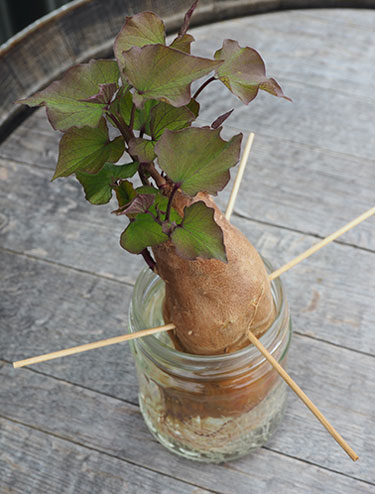Kids Go Gardening - grow kumara
Fun to grow, good to eat!
From just one kumara tuber, you can grow lots more! The first step is to grow little kumara plants from the same kumara that we would normally eat. You can plant your kumara tubers in potting mix, or in a jar so you can watch the roots grow.
Then plant it in a pot as a houseplant (cutting it back if it gets too big) or use the shoots to grow loads of kumara to eat.
Grow your own kumara
- Sit your kumara tuber in a jar of water, using toothpicks to hold it up.
- Place it in a bright sunny place indoors, such as a sunny windowsill, and keep watch.
- In about a week it should be sprouting roots and leafy shoots. Check the water each day. Replace the water if it gets slimy; tip it out and rinse the roots and wash the jar. Keep the water level above the roots.
- When the shoots are 20cm or longer, gently remove the shoots to grown into new plants called ‘slips ’ or ‘tipu'. If they don’t already have roots, new roots will soon grow!
- Place your detached slips in a glass of water so you can watch the roots as they keep growing, or plant them straight into pots filled with potting mix.
- When it’s warm enough, (about late October in the North Island), plant them out into sunny garden soil. The soil must be warm, at least 18°C, with no more frosts to come. In cooler climates with shorter winters, gardeners grow kumara in pots that are kept covered and protected from the cold.
- Your kūmara will be ready to harvest in late summer or autumn.
A bumper crop!
Olivia grows 12 little plants from her one kumara tuber. In spring she plants them out in the garden, and all grow into healthy big plants. At the end of summer, she digs up nine big kumara for every plant she planted. How many kumara did Olivia end up growing from that one she started with? If each big kumara was worth $3 at the supermarket, how much money did she save?
Did you know?
Kumara arrived in Aotearoa over a thousand years ago. They were brought here on Maori canoes from the Pacific islands. Kumara planting and harvest were special spiritual events for the Maori people who had to work out how to grow their crops in a much cooler climate.
In Hamilton Gardens there is a special traditional kumara patch. Kumara are planted in mounds with stones on top to keep them warm. Go to hamiltongardens.com to find out more and watch the harvest video.
Veges that grow underground
Some plants store the nutrients and energy they need for next seasons growing underground in bulbs, roots or tubers. Tubers are fat pieces of stems or roots that grow underground. Stem tubers include potatoes and yams. Kumara and sweet potatoes are root tubers.
Bulbs are short stubby bits of stem with fleshy ‘leaves’. Garlic and onions are bulbs we eat. Winter is planting time for garlic.
Roots that we grow for eating are carrots, parsnips, beetroot and radishes. Grow these veges from seed sown straight into big pots or garden beds.
ANSWER:
108 kumara; saved $324!

1-Jul-2022


Teparapara at Hamilton Gardens

